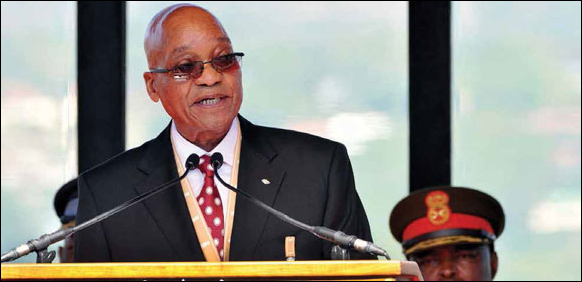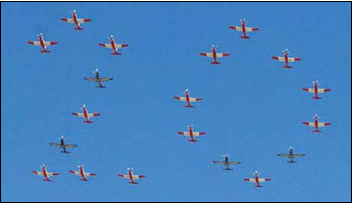The President of the Republic of South Africa, President Jacob Gedleyihlekisa Zuma, was born on 12 April 1942 at KwaNxamalala in Nkandla, northern KwaZulu-Natal.
 His early political consciousness was shaped by his cousin, Muntukabongwa Zuma, who had fought in the Second World War and later joined the trade union movement and the African National Congress (ANC) in Durban. The young Jacob Zuma was drawn into the organisation and attended its meetings in Mkhumbane (Cator Manor).
His early political consciousness was shaped by his cousin, Muntukabongwa Zuma, who had fought in the Second World War and later joined the trade union movement and the African National Congress (ANC) in Durban. The young Jacob Zuma was drawn into the organisation and attended its meetings in Mkhumbane (Cator Manor).
The President joined the ANC Youth League and the South African Congress of Trade Unions in 1959. The 1950s were characterised by the Defiance Campaign, the adoption of the Freedom Charter during the Congress of the People held in Kliptown in 1955, the anti-pass campaigns and the historic 1956 Women’s March on the Union Buildings.
This was also a decade of the implementation of the most brutal, ruthless and draconian apartheid laws, including the Suppression of Communism Act and the Group Areas Act, as well as the first of a series of treason trials, including the 1956 Treason Trial.
President Zuma was recruited into Umkhonto We Sizwe by the stalwart of the liberation struggle, the late Moses Mabhida and participated in sabotage operations in KwaZulu-Natal. He was arrested in June 1963 near Zeerust in present-day North West. On 12 August 1963, he was sentenced to 10 years’ imprisonment on Robben Island. He was only 21 years old when he began serving his sentence. He was released from Robben Island Maximum Security Prison in 1973.
Robben Island became a university to him in the true sense of the word, as he continued receiving his political education as well as general education with the help of his comrades.
The struggle continues in exile
During his period in exile, President Zuma was based in Swaziland and Mozambique, where he led most of his outstanding operations.
In 1977 he was appointed to serve in the Maputo Regional Committee, and in the same year, was also co-opted as a member of the ANC National Executive Committee (NEC), while at the same time he also began working for the SACP. In 1978, he completed a three-month leadership and military training course in the then Soviet Union.
In 1984, President Zuma was appointed the Deputy Chief Representative of the ANC, and later as Chief Representative of the ANC, and remained in Mozambique. He was re-elected to the ANC’s NEC at the Kabwe Conference in 1985. He also served on the ANC’s Politico- Military Council after its formation in the mid-80s, and the Intelligence Department at the ANC Head Office in Lusaka, Zambia.
When the ANC began to talk to the apartheid regime in the 1980s President Oliver Tambo selected Mr Zuma and former President Thabo Mbeki to execute this task.
The NEC selected President Zuma to lead the compact advance group that came into the country to prepare for the commencement of Talks-about-Talks after the release of former President Mandela and the unbanning of political organisations by the last President of the white minority-based Republic, Mr FW de Klerk, in 1990.
 In November 1990, President Zuma was elected Chairperson of the ANC’s Southern Natal region. In 1991, at the first ANC conference held in South Africa since 1959, he was elected Deputy Secretary-General, serving under the current ANC and South Africa’s Deputy President, Mr Cyril Ramaphosa, who was Secretary-General at the time.
In November 1990, President Zuma was elected Chairperson of the ANC’s Southern Natal region. In 1991, at the first ANC conference held in South Africa since 1959, he was elected Deputy Secretary-General, serving under the current ANC and South Africa’s Deputy President, Mr Cyril Ramaphosa, who was Secretary-General at the time.
During this period violence was still continuing in KwaZulu-Natal and the then PWV area (now Gauteng). The apartheid state security forces led a sustained and brutal covert campaign against the ANC and allied organisations in KwaZulu-Natal and Gauteng.
His strategic thinking and conflict resolution skills played a pivotal role in ending conflict in KwaZulu-Natal and Gauteng.
In 1994 he was appointed MEC of Economic Affairs and Tourism for the KwaZulu-Natal provincial government.
As MEC, Mr Zuma worked hard to develop the tourism industry in the province and facilitated new investments into the KwaZulu-Natal economy.
In December 1994, he was elected National Chairperson of the ANC. An exception was made in the ANC Constitution to allow him to serve as both Provincial Chairperson and National Chairperson.



 Facebook
Facebook Twitter
Twitter WhatsApp
WhatsApp